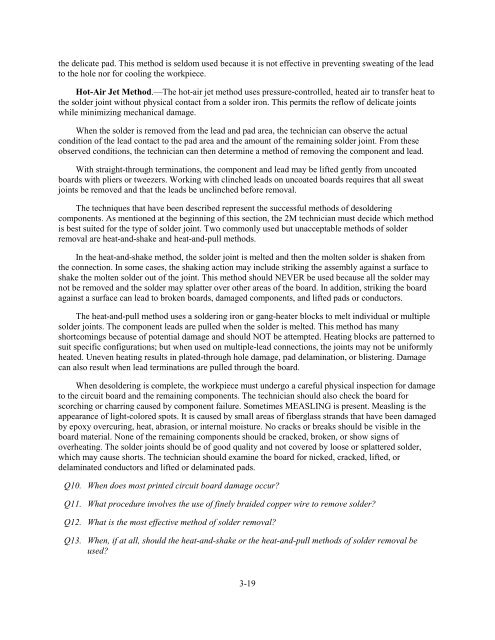Navy Electricity and Electronics Training Series - Historic Naval ...
Navy Electricity and Electronics Training Series - Historic Naval ...
Navy Electricity and Electronics Training Series - Historic Naval ...
You also want an ePaper? Increase the reach of your titles
YUMPU automatically turns print PDFs into web optimized ePapers that Google loves.
the delicate pad. This method is seldom used because it is not effective in preventing sweating of the leadto the hole nor for cooling the workpiece.Hot-Air Jet Method.—The hot-air jet method uses pressure-controlled, heated air to transfer heat tothe solder joint without physical contact from a solder iron. This permits the reflow of delicate jointswhile minimizing mechanical damage.When the solder is removed from the lead <strong>and</strong> pad area, the technician can observe the actualcondition of the lead contact to the pad area <strong>and</strong> the amount of the remaining solder joint. From theseobserved conditions, the technician can then determine a method of removing the component <strong>and</strong> lead.With straight-through terminations, the component <strong>and</strong> lead may be lifted gently from uncoatedboards with pliers or tweezers. Working with clinched leads on uncoated boards requires that all sweatjoints be removed <strong>and</strong> that the leads be unclinched before removal.The techniques that have been described represent the successful methods of desolderingcomponents. As mentioned at the beginning of this section, the 2M technician must decide which methodis best suited for the type of solder joint. Two commonly used but unacceptable methods of solderremoval are heat-<strong>and</strong>-shake <strong>and</strong> heat-<strong>and</strong>-pull methods.In the heat-<strong>and</strong>-shake method, the solder joint is melted <strong>and</strong> then the molten solder is shaken fromthe connection. In some cases, the shaking action may include striking the assembly against a surface toshake the molten solder out of the joint. This method should NEVER be used because all the solder maynot be removed <strong>and</strong> the solder may splatter over other areas of the board. In addition, striking the boardagainst a surface can lead to broken boards, damaged components, <strong>and</strong> lifted pads or conductors.The heat-<strong>and</strong>-pull method uses a soldering iron or gang-heater blocks to melt individual or multiplesolder joints. The component leads are pulled when the solder is melted. This method has manyshortcomings because of potential damage <strong>and</strong> should NOT be attempted. Heating blocks are patterned tosuit specific configurations; but when used on multiple-lead connections, the joints may not be uniformlyheated. Uneven heating results in plated-through hole damage, pad delamination, or blistering. Damagecan also result when lead terminations are pulled through the board.When desoldering is complete, the workpiece must undergo a careful physical inspection for damageto the circuit board <strong>and</strong> the remaining components. The technician should also check the board forscorching or charring caused by component failure. Sometimes MEASLING is present. Measling is theappearance of light-colored spots. It is caused by small areas of fiberglass str<strong>and</strong>s that have been damagedby epoxy overcuring, heat, abrasion, or internal moisture. No cracks or breaks should be visible in theboard material. None of the remaining components should be cracked, broken, or show signs ofoverheating. The solder joints should be of good quality <strong>and</strong> not covered by loose or splattered solder,which may cause shorts. The technician should examine the board for nicked, cracked, lifted, ordelaminated conductors <strong>and</strong> lifted or delaminated pads.Q10. When does most printed circuit board damage occur?Q11. What procedure involves the use of finely braided copper wire to remove solder?Q12. What is the most effective method of solder removal?Q13. When, if at all, should the heat-<strong>and</strong>-shake or the heat-<strong>and</strong>-pull methods of solder removal beused?3-19

















